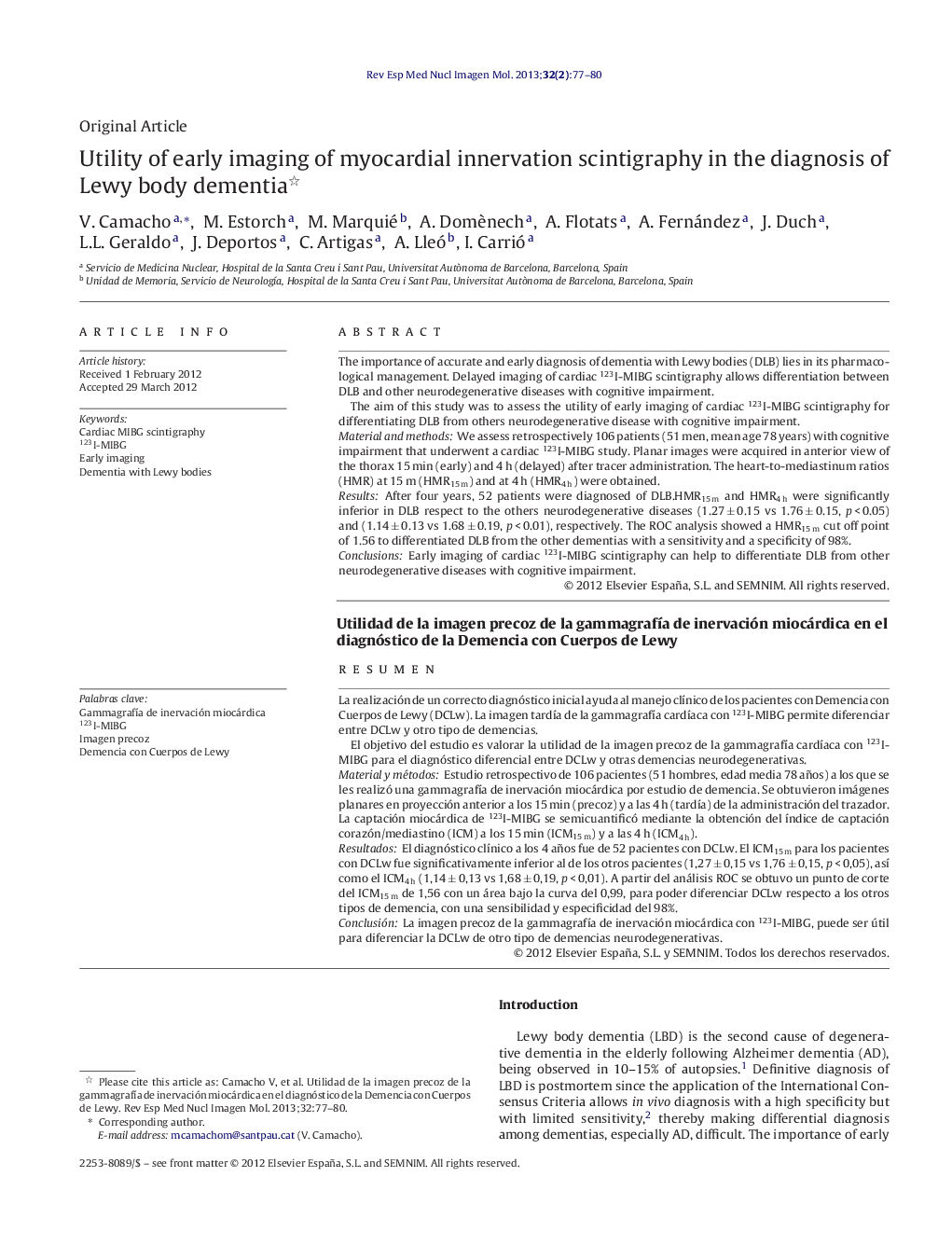| Article ID | Journal | Published Year | Pages | File Type |
|---|---|---|---|---|
| 4250545 | Revista Española de Medicina Nuclear e Imagen Molecular (English Edition) | 2013 | 4 Pages |
The importance of accurate and early diagnosis of dementia with Lewy bodies (DLB) lies in its pharmacological management. Delayed imaging of cardiac 123I-MIBG scintigraphy allows differentiation between DLB and other neurodegenerative diseases with cognitive impairment.The aim of this study was to assess the utility of early imaging of cardiac 123I-MIBG scintigraphy for differentiating DLB from others neurodegenerative disease with cognitive impairment.Material and methodsWe assess retrospectively 106 patients (51 men, mean age 78 years) with cognitive impairment that underwent a cardiac 123I-MIBG study. Planar images were acquired in anterior view of the thorax 15 min (early) and 4 h (delayed) after tracer administration. The heart-to-mediastinum ratios (HMR) at 15 m (HMR15 m) and at 4 h (HMR4 h) were obtained.ResultsAfter four years, 52 patients were diagnosed of DLB.HMR15 m and HMR4 h were significantly inferior in DLB respect to the others neurodegenerative diseases (1.27 ± 0.15 vs 1.76 ± 0.15, p < 0.05) and (1.14 ± 0.13 vs 1.68 ± 0.19, p < 0.01), respectively. The ROC analysis showed a HMR15 m cut off point of 1.56 to differentiated DLB from the other dementias with a sensitivity and a specificity of 98%.ConclusionsEarly imaging of cardiac 123I-MIBG scintigraphy can help to differentiate DLB from other neurodegenerative diseases with cognitive impairment.
ResumenLa realización de un correcto diagnóstico inicial ayuda al manejo clínico de los pacientes con Demencia con Cuerpos de Lewy (DCLw). La imagen tardía de la gammagrafía cardíaca con 123I-MIBG permite diferenciar entre DCLw y otro tipo de demencias.El objetivo del estudio es valorar la utilidad de la imagen precoz de la gammagrafía cardíaca con 123I-MIBG para el diagnóstico diferencial entre DCLw y otras demencias neurodegenerativas.Material y métodosEstudio retrospectivo de 106 pacientes (51 hombres, edad media 78 años) a los que se les realizó una gammagrafía de inervación miocárdica por estudio de demencia. Se obtuvieron imágenes planares en proyección anterior a los 15 min (precoz) y a las 4 h (tardía) de la administración del trazador. La captación miocárdica de 123I-MIBG se semicuantificó mediante la obtención del índice de captación corazón/mediastino (ICM) a los 15 min (ICM15 m) y a las 4 h (ICM4 h).ResultadosEl diagnóstico clínico a los 4 años fue de 52 pacientes con DCLw. El ICM15 m para los pacientes con DCLw fue significativamente inferior al de los otros pacientes (1,27 ± 0,15 vs 1,76 ± 0,15, p < 0,05), así como el ICM4 h (1,14 ± 0,13 vs 1,68 ± 0,19, p < 0,01). A partir del análisis ROC se obtuvo un punto de corte del ICM15 m de 1,56 con un área bajo la curva del 0,99, para poder diferenciar DCLw respecto a los otros tipos de demencia, con una sensibilidad y especificidad del 98%.ConclusiónLa imagen precoz de la gammagrafía de inervación miocárdica con 123I-MIBG, puede ser útil para diferenciar la DCLw de otro tipo de demencias neurodegenerativas.
